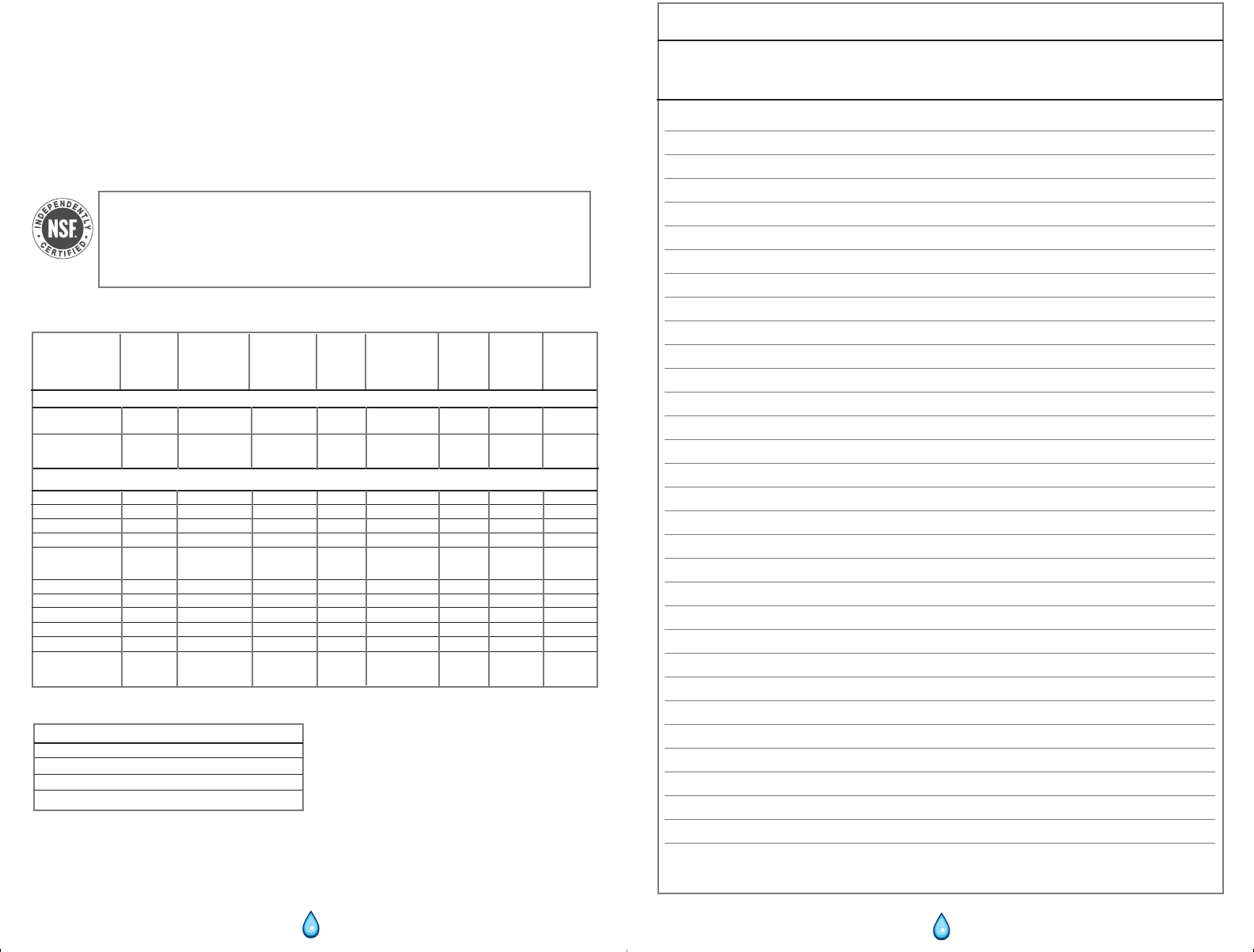
Performance Data Sheet
for CLEAR2O Models CWS100A and CWS100B
with Replacement Cartridge CWF100
Chemical, Mechanical Reduction Filter
This system has been tested according to NSF/ANSI Standards 42 and 53 for the reduction
of the substances listed below.
The concentration of the indicated substances in water entering the system was reduced to
a concentration less than or equal to the permissible limit for water leaving the system as
specified in NSF/ANSI 42 and 53.
Capacity: 40 gallons (151 liters) depending on local water conditions
System tested and certified by NSF International against NSF/ANSI
Standard 42 for the reduction of Chlorine Taste and Odor, Particulate
Nominal Class I and against NSF/ANSI Standard 53 for the reduction of
Lead, Mercury, Asbestos, Cadmium, MTBE, Toxaphene, VOC, Cyst,
Turbidity.
Substance Average Influent Average Product Average Max. Permissible Max Min. % NSF
Influent Challenge Water % Product Effluent Reduction Test
Concentration Concentration Concentration Reduction Water
Concentrations
as mg/L
NSF/ANSI Standard 42 – AESTHETIC EFFECTS
Chlorine taste 2.0 mg/L±10% Ȅ50%
and odor
Particulate At least 10,000 Ȅ85%
Class I Particle particles/ml
size: 0.5 to < 1.0 um
NSF/ANSI Standard 53 – HEALTH EFFECTS
Lead, pH=6.5 0.15 mg/L±10% 0.01
Lead, pH=8.5 0.15 mg/L±10% 0.01
Mercury, pH=6.5 0.0006 mg/L+/10% 0.002
Mercury, pH=8.5 0.0006 mg/L+/10% 0.002
Asbestos 10
7
to 10
8
fibers/L; 99%
fibers greater than
10 um in length
Cadmium 0.03 mg/L±10% 0.005
MTBE 0.015 mg/L±20% 0.005
Toxaphene 0.015+/10% 0.003
VOC 0.30 mg/L±10% >95%
Cysts* Minimum 50,000/L 99.95%
Turbidity 11±NTU 0.5 NTU
Application Guidelines/Water Supply Parameters
Service flow 1 gpm (3.8 lpm)
Water supply Community or private well
Water pressure 20-100 psig (138-690 kPa)
Water temperature 40°F - 100°F (4°C - 38°C)
* Based on the use of Cryptosporidium parvum oocysts
Organic Chemicals Included by Surrogate Testing
Chemical Influent Chemical Maximum
Challenge Level Reduction Product Water
mg/L Percent Level mg/L
alachlor 0.05 >98 0.001
atrazine 0.100 >97 0.003
benzene 0.081 >99 0.001
carbofuran 0.190 >99 0.001
carbon tetrachloride 0.078 98 0.0018
chlorobenzene 0.077 >99 0.001
chloropicrin 0.015 99 0.0002
2,4-D 0.110 98 0.0017
dibromochloropropane (DBCP) 0.052 >99 0.00002
o-dichlorobenzene 0.080 >99 0.001
p-dichlorobenzene 0.040 >98 0.001
1,2-dichloroethane 0.088 95
5
0.0048
1,1-dichloroethylene 0.083 >99 0.001
cis-1,2-dichloroethylene 0.170 >99 0.0005
trans-1,2-dichloroethylene 0.086 >99 0.001
1,2-dichloropropane 0.080 >99 0.001
cis-1,3-dichloropropylene 0.079 >99 0.001
dinoseb 0.170 99 0.0002
endrin 0.053 99 0.00059
ethylbenzene 0.088 >99 0.001
ethylene dibromide (EDB) 0.044 >99 0.00002
haloacetonitriles (HAN)
bromochloroacetonitrile 0.022 98 0.0005
dibromoacetonitrile 0.024 98 0.0006
dichloroacetonitrile 0.0096 98 0.0002
trichloroacetonitrile 0.015 98 0.0003
haloketones (HK)
1,1-dichloro-2-propanone 0.0072 99 0.0001
1,1,1-trichloro-2-propanone 0.0082 96 0.0003
heptachlor 0.25
1
>99 0.0001
1
heptachlor epoxide 0.0107 98 0.0002
hexachlorobutadiene 0.044 >98 0.001
Note that while the testing was performed under standard
laboratory conditions, actual performance may vary.
Systems must be installed and operated in accordance with
manufacturer’s recommended procedures and guidelines.
9
10
CWS100APub1000002828 2/23/06 7:12 AM Page 10











